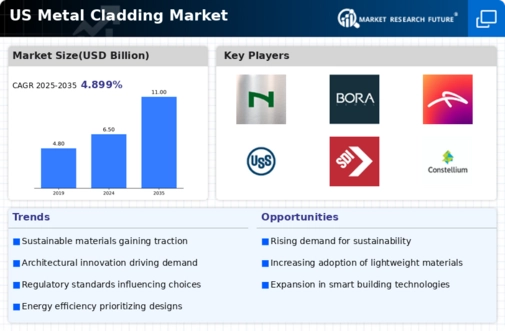Energy Efficiency Initiatives
Energy efficiency initiatives are becoming increasingly critical in the US, influencing the metal cladding market. With rising energy costs and a growing emphasis on sustainability, building owners are seeking materials that enhance energy performance. Metal cladding, particularly when combined with insulation, can significantly reduce energy consumption, leading to lower utility bills. According to the US Department of Energy, buildings account for nearly 40% of total energy use, highlighting the potential impact of energy-efficient materials. As regulations and incentives for energy-efficient construction become more prevalent, the metal cladding market is likely to benefit from heightened demand, as stakeholders prioritize energy-saving solutions in their projects.
Rising Construction Activities
The metal cladding market is experiencing a surge due to increasing construction activities across various sectors, including residential, commercial, and industrial. In the US, the construction industry has shown a robust growth trajectory, with an estimated value of $1.36 trillion in 2025. This growth is likely to drive demand for metal cladding, as builders and architects seek durable and aesthetically pleasing materials. Metal cladding offers advantages such as low maintenance, energy efficiency, and design flexibility, making it a preferred choice in modern construction. As urbanization continues to rise, the need for innovative building solutions will further bolster the metal cladding market, indicating a promising outlook for manufacturers and suppliers in this industry.
Architectural Trends Favoring Metal
Architectural trends in the US are increasingly favoring the use of metal cladding, which is reshaping the landscape of the metal cladding market. Modern designs often incorporate sleek, contemporary aesthetics that metal cladding can provide. The versatility of metal allows for various finishes and colors, appealing to architects and designers aiming for innovative structures. Additionally, the durability and longevity of metal cladding make it an attractive option for long-term investments. As more architects embrace these trends, the demand for metal cladding is expected to rise, suggesting a positive trajectory for the industry. This shift in architectural preferences could lead to a significant increase in market share for metal cladding manufacturers.
Increased Focus on Safety Standards
The metal cladding market is also influenced by an increased focus on safety standards in construction. In the US, building codes and regulations are becoming more stringent, particularly concerning fire safety and structural integrity. Metal cladding materials, known for their fire-resistant properties, are gaining traction as builders seek to comply with these evolving standards. The National Fire Protection Association (NFPA) has emphasized the importance of using non-combustible materials in construction, which positions metal cladding favorably in the market. As safety becomes a paramount concern, the demand for compliant materials is likely to drive growth in the metal cladding market, benefiting manufacturers who prioritize safety in their product offerings.
Technological Innovations in Manufacturing
Technological innovations in manufacturing processes are playing a pivotal role in shaping the metal cladding market. Advances in production techniques, such as automated fabrication and precision engineering, are enhancing the quality and efficiency of metal cladding products. These innovations allow for greater customization and reduced lead times, making it easier for builders to incorporate metal cladding into their projects. Furthermore, the integration of smart technologies in manufacturing can lead to improved sustainability practices, aligning with the industry's shift towards eco-friendly solutions. As these technological advancements continue to evolve, they are likely to create new opportunities for growth within the metal cladding market, enabling manufacturers to meet the changing demands of the construction sector.























Leave a Comment